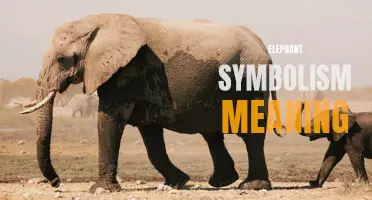
Peru, a country rich in history and culture, is home to a fascinating array of symbols and meanings that hold deep significance for its people. These symbols reflect the diverse traditions, beliefs, and experiences of the Peruvian people, and serve as a powerful reminder of their rich heritage. From the vibrant colors of the Andean textiles to the majestic condor soaring through the skies, each symbol tells a unique story and carries a profound message. Join us on a journey through the world of Peruvian symbols, where we will delve into their meanings and uncover the hidden treasures of this enchanting land.
What You'll Learn
- What are some commonly recognized symbols in Peruvian culture and what do they represent?
- How have these symbols evolved and changed over time in Peruvian history?
- Are there any symbols in Peruvian culture that are exclusive to certain regions or indigenous groups?
- How are these symbols incorporated into Peruvian art, fashion, and design?
- What is the significance of these symbols in Peruvian day-to-day life and celebrations?

What are some commonly recognized symbols in Peruvian culture and what do they represent?
Peru is renowned for its rich cultural heritage, and one of the most interesting aspects of the country's culture is its abundance of traditional symbols. These symbols play an essential role in Peruvian society, representing various aspects of their history, religion, and identity. Here are some commonly recognized symbols in Peruvian culture and what they represent.
- Inti Raymi - The Inti Raymi is an ancient Inca festival that celebrates the sun god, Inti. It is one of the most important ceremonies in Inca culture and is still widely celebrated in modern-day Peru. The festival represents the agricultural cycle and the Inca's dependence on the sun for their crops.
- Chakana - Also known as the Andean Cross, the Chakana is a sacred symbol in Inca and Andean cultures. It represents the three levels of existence - the underworld, the earth, and the heavens - as well as the four natural elements of water, earth, air, and fire. The Chakana symbolizes the harmony and balance between these elements.
- Condor - The condor is a large bird that holds significant symbolism in Andean cultures, including Peru. It is associated with power, strength, and freedom. In Peruvian folklore, the condor is believed to be a messenger between the world of the living and the world of the dead.
- Pachamama - Pachamama is the goddess of fertility and agriculture in Inca mythology. She is often depicted as a motherly figure, representing the earth and its abundance. Pachamama is highly respected by Peruvians, who offer her offerings of gratitude and respect for their land's bounty.
- Andean Mountains - The Andean Mountains are a dominant feature of Peru's landscape, and they hold great importance in Peruvian culture. They are considered sacred and are believed to be the dwelling place of various gods and spirits. The Andean Mountains also symbolize the connection between the earth and the heavens.
- Huaca - A huaca is a sacred site or object in Inca culture. These can include natural sites like mountains or springs, as well as man-made structures like temples and ruins. Huacas are seen as places of spiritual power and are often venerated and respected by Peruvians.
- Cuy - Known as guinea pig in English, the cuy is a traditional and symbolic animal in Peruvian culture. It has been consumed in Peru for thousands of years and holds cultural significance. Cuy is often associated with celebratory feasts and represents abundance and prosperity.
These symbols are just a few examples of the vast and diverse cultural heritage of Peru. They showcase the deep historical roots and spiritual beliefs that have shaped Peruvian society over the centuries. Understanding these symbols not only helps to appreciate Peru's rich culture but also provides insights into the values and customs that continue to influence the lives of its people today.
The Symbolic Meaning Behind Flickering Lights and What It Signifies
You may want to see also

How have these symbols evolved and changed over time in Peruvian history?
Symbols play a significant role in shaping the cultural and historical identity of a nation. In the case of Peru, there are several symbols that have evolved and changed over time, reflecting various aspects of the country's history.
One of the most prominent symbols is the Peruvian flag. The flag consists of three vertical stripes - red, white, and red, with the national coat of arms in the middle of the white stripe. The red stripes represent the blood shed by those who fought for independence, while the white symbolizes peace and purity. The coat of arms features a vicuña, a national animal, surrounded by a wreath of palm and laurel branches, signifying victory and honor. This flag has remained relatively unchanged since its adoption in 1825.
Another symbol that has evolved over time is the national anthem of Peru. The current anthem, titled "Himno Nacional del Perú," was composed by José de la Torre Ugarte in 1821. However, the lyrics to the anthem have undergone several revisions over the years to reflect the changing political and social landscape of Peru. The original lyrics celebrated the country's independence, but subsequent versions emphasized themes of national unity and patriotism. Furthermore, the anthem has been adapted to include verses that honor Peruvian heroes and promote national pride.
In addition to these national symbols, there are also regional symbols that have evolved alongside Peru's history. For example, the traditional dress of indigenous Peruvian communities has changed over time. These garments, made from colorful textiles and intricate weavings, are a symbol of cultural identity and heritage. However, the designs and patterns have adapted to incorporate modern styles and materials, reflecting the influences of globalization and urbanization.
Furthermore, certain symbols have been adopted or co-opted by political movements throughout Peru's history. For instance, the Inti Raymi, an ancient Inca festival celebrating the sun god Inti, has been used as a symbol of Indigenous pride and resistance against colonialism. Similarly, the Chakana, or Andean cross, has been incorporated into various political and social movements as a symbol of solidarity and the reclaiming of Indigenous cultural heritage.
Overall, symbols in Peruvian history have evolved and changed over time, reflecting the country's political, social, and cultural developments. From the national flag and anthem to indigenous garments and ancient rituals, these symbols continue to shape and define Peru's rich and diverse identity. As the nation continues to grow and evolve, it is likely that these symbols will continue to adapt and change to reflect the ever-changing landscape of Peruvian history.
Decoding the Symbolic Language of Tower Fans: Unraveling the Meaning Behind the Enigmatic Icons
You may want to see also

Are there any symbols in Peruvian culture that are exclusive to certain regions or indigenous groups?
Peru is a country rich in cultural diversity, with various regions and indigenous groups that have their own unique symbols and practices. These symbols often represent important aspects of the local culture, history, and natural surroundings. In this article, we will explore some of the symbols exclusive to certain regions or indigenous groups in Peru.
One of the most iconic symbols associated with the Inca civilization is the Inti Raymi, or Festival of the Sun. This ancient ritual takes place in Cusco, the former capital of the Inca Empire. It celebrates the winter solstice and pays homage to Inti, the Sun God. The festival includes colorful processions, music, dance, and the reading of ancient prayers. It is a vibrant and spiritual event that showcases the Inca's deep connection with nature and the cosmos.
In the region of Puno, located in southern Peru, the indigenous group known as the Uros people have their own distinct symbols. The Uros are known for their unique way of life on floating islands made of totora reeds in Lake Titicaca. One important symbol for the Uros is the totora reed itself. It represents their resourcefulness and their ability to adapt to the harsh conditions of the lake. The Uros also use symbols such as geometric patterns in their textile art, which reflects their deep understanding of the natural world.
Moving to the north of Peru, we find the Moche civilization, known for its impressive pottery and metalwork. The Moche people had a complex society with rich symbolism. One prominent symbol in their art is the serpent. Serpents were believed to possess spiritual powers and were associated with water, fertility, and agriculture. The Moche also depicted animals such as jaguars, which symbolized power and strength. These symbols can be seen in their intricate ceramics and murals, providing insights into the culture and beliefs of this ancient civilization.
In the Amazon rainforest region of Peru, various indigenous groups have their own symbols and practices. One example is the Shipibo-Conibo people, known for their intricate textile art. They use geometric patterns that represent their cosmology and traditional knowledge. These patterns are said to have a symbolic and spiritual meaning, with each design telling a story or conveying a specific message. The Shipibo-Conibo also incorporate natural elements such as plants, animals, and rivers into their intricate designs.
It is important to note that while certain symbols may be exclusive to specific regions or indigenous groups, there are also shared symbols and practices that have been adopted and adapted throughout Peru. The country's multicultural heritage has created a rich tapestry of symbols and traditions that continue to be celebrated and cherished.
In conclusion, Peru is a country with a vast array of symbols, each representing a unique aspect of its diverse culture. From the Inti Raymi festival in Cusco to the symbols of the Uros people in Puno, the Moche civilization in the north, and the Shipibo-Conibo people in the Amazon, these symbols reveal the deep connections between the people and their environment. Exploring these symbols provides a glimpse into the rich history and cultural heritage of Peru.
Understanding Addiction Recovery Symbols and Their Meanings
You may want to see also

How are these symbols incorporated into Peruvian art, fashion, and design?
Symbols play a significant role in Peruvian art, fashion, and design, reflecting the rich cultural heritage of the country. These symbols incorporate both ancient and modern influences, creating a unique and vibrant aesthetic that is distinctively Peruvian.
In Peruvian art, symbols are used to convey various meanings and tell stories about the country's history, traditions, and belief systems. One of the most prominent symbols is the Inti, or the sun god. Represented as a radiant sun, the Inti symbolizes fertility, abundance, and power. It is often depicted in intricate textiles, pottery, and murals, showcasing the skilled craftsmanship of Peruvian artists.
Another symbol frequently seen in Peruvian art is the Chakana, also known as the Andean Cross. This cross-like symbol represents the three realms of existence in Andean cosmology – the underworld, the earthly plane, and the celestial realm. It signifies balance and harmony and is often incorporated into jewelry, clothing, and architectural designs.
In addition to these ancient symbols, modern Peruvian artists often incorporate representations of animals, such as llamas, alpacas, and condors, into their work. These animals hold special significance in Peruvian culture and are revered for their strength, resilience, and connection to the natural world.
Peruvian fashion and design also draw inspiration from these symbols, creating a fusion of tradition and contemporary style. Textiles, in particular, play a crucial role in Peruvian fashion, with intricate patterns and vibrant colors adorning clothing and accessories. Traditional weaving techniques, handed down through generations, are still used to create these textiles, resulting in unique and highly detailed designs.
Symbols such as the Inti and the Chakana are often incorporated into these textiles, adding historical and cultural significance. These symbols can be found on ponchos, scarves, and bags, reflecting the pride Peruvians have in their heritage and their desire to preserve and promote their traditions.
Peruvian fashion designers also experiment with innovative ways to incorporate symbols into their designs. They use elements such as embroidery, appliqué, and beadwork to create intricate patterns that capture the essence of Peruvian culture. These designs are then translated into modern silhouettes and fabrications, resulting in clothing that is both traditional and contemporary.
In the field of design, Peruvians draw inspiration from their rich cultural history to create unique and visually stunning products. From home decor items to furniture and ceramics, Peruvian designers incorporate symbols into their creations, infusing them with a sense of heritage and authenticity.
Symbols such as the Inti and the Chakana are often used in pattern designs, giving everyday objects a touch of Peruvian charm. These symbols serve as a reminder of the country's rich cultural tapestry and help to preserve its traditions in a modern context.
In conclusion, symbols play a vital role in Peruvian art, fashion, and design. They serve as a link to the country's ancient history and cultural heritage, while also adding a unique and vibrant aesthetic to contemporary creations. Whether incorporated into textiles, accessories, or home decor, these symbols captivate audiences and share the stories and traditions of Peru with the world.
Exploring the Symbolic Meanings behind Baby Brezza Symbols
You may want to see also

What is the significance of these symbols in Peruvian day-to-day life and celebrations?
Peru is a country rich in culture and traditions, and many of these traditions are closely tied to symbols that hold deep significance in Peruvian day-to-day life and celebrations. These symbols represent the history, beliefs, and values of the Peruvian people, and are an important part of their identity.
One of the most well-known symbols in Peru is the Andean cross, also known as the "chakana". This symbol is made up of three steps on each side, forming a square with a diagonal cross in the center. The chakana is believed to represent the three levels of existence in Andean cosmology - the upper world, the middle world, and the lower world. It is also believed to symbolize the balance between the forces of nature and human beings, as well as the harmonious relationship between the physical, spiritual, and natural worlds. The chakana is often used in traditional Andean ceremonies, such as offerings to the gods and rituals for the harvest, as well as in everyday life as a symbol of protection and good luck.
Another important symbol in Peruvian day-to-day life and celebrations is the sun. The sun has long been revered by the Peruvian people as a source of warmth, light, and life. In ancient times, the Incas worshipped the sun as the highest deity in their pantheon, and the sun was considered the giver of life and the ruler of the world. Today, the sun continues to hold a central place in Peruvian culture, and is often depicted in traditional artwork, textiles, and pottery. The Inti Raymi, or Festival of the Sun, is a major celebration held in Cusco every June, where people gather to pay tribute to the sun and give thanks for its blessings.
The condor is another symbol that holds great significance in Peruvian day-to-day life and celebrations. The condor is the largest bird in the Andes and is considered a sacred animal in Andean culture. It is believed to be a messenger between the gods and the human world, and is often associated with the spirit world and the afterlife. The condor is also seen as a symbol of power, strength, and freedom. In Peruvian celebrations and rituals, the condor is often depicted in artwork, dances, and ceremonies to honor and pay respect to the spirits and ancestors.
The Pachamama, or Mother Earth, is another symbol that plays a central role in Peruvian day-to-day life and celebrations. Pachamama is believed to be the goddess of fertility and abundance, and is revered as a provider and sustainer of life. The Peruvian people have a deep connection with the land and nature, and view the Pachamama as a sacred being. In traditional ceremonies and rituals, offerings are made to the Pachamama to show gratitude and ask for protection and blessings.
These symbols are just a few examples of the rich cultural heritage and traditions of Peru. They represent the deep spiritual connection that the Peruvian people have with their history, land, and traditions, and are an integral part of their day-to-day life and celebrations. Through these symbols, the Peruvian people are able to reaffirm their identity, values, and beliefs, and honor their ancestors and the natural world.
Unveiling the Profound Meanings of Kabbalah Symbols
You may want to see also
Frequently asked questions
Some important symbols in Peruvian culture include the Andean condor, which represents freedom and power, the sun god Inti, symbolizing vitality and energy, and the Inca Cross, also known as the Chakana, which represents the three levels of existence: the physical world, the underground world, and the celestial world.
The Andean condor is a powerful symbol in Peru, representing freedom, power, and the connection between the earthly and spiritual realms. It is also associated with the Inca civilization and is believed to be a messenger between the gods and humans.
Inti is the sun god in Peruvian culture and is highly revered as the source of life and energy. The Inca civilization considered the sun to be the most important deity, and Inti was worshipped as the ruler of the heavens. The sun god symbolizes vitality, power, and prosperity.
The Inca Cross, also known as the Chakana, is a symbol that represents the three levels of existence in Inca cosmology. The cross has four arms that represent the four cardinal points, with a hole in the center symbolizing the connection between the three worlds: the physical world, the underground world, and the celestial world. It is also believed to represent balance, harmony, and the concept of the duality of life.







